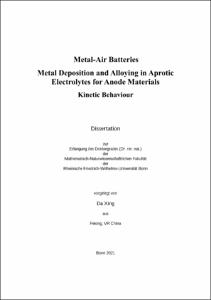Metal-Air Batteries: Metal Deposition and Alloying in Aprotic Electrolytes for Anode MaterialsKinetic Behaviour

Metal-Air Batteries: Metal Deposition and Alloying in Aprotic Electrolytes for Anode Materials
Kinetic Behaviour

| dc.contributor.advisor | Baltruschat, Helmut | |
| dc.contributor.author | Xing, Da | |
| dc.date.accessioned | 2022-01-03T08:13:13Z | |
| dc.date.available | 2023-02-01T23:00:15Z | |
| dc.date.issued | 03.01.2022 | |
| dc.identifier.uri | https://hdl.handle.net/20.500.11811/9522 | |
| dc.description.abstract | Metal air batteries concerning the increase in storage capacity, increase the lifetime, and reduction of weight, size and costs leads to more and more interest in battery research. The alloying-type anodes (Sb, Sn, and Bi as host material) for magnesium and calcium batteries are good choices for rechargeable metal batteries because of their high electrochemical properties. The lithium deposition/dissolution are investigated in 1 M and 3 M LiTFSI/DMSO solution on Au and Pt electrode. The highest coulombic efficiency of Li deposition/dissolution is observed in 3 M solution on Au electrode. MACC/TG and Mg(BH4)2/TG electrolyte systems show high reversibility and high coulombic efficiency (99 %). However, the freshly prepared MACC/TG electrolyte needs to be conditioned until it shows high reversible magnesium plating and stripping and the Al and Cl co-deposition is observed. High concentration of Mg(BH4)2/TG (1.5 M) electrolytes results in a coulombic efficiency of 70 % without addition of MgCl2. With an addition of 0.5 M MgCl2 the coulombic efficiency increase to 98 %. No reversible Ca deposition or alloying were observed in most Ca2+ containing electrolytes except 1.5 M Ca(BH4)2/THF (up to 98 % coulombic efficiency and 100 mV overpotential). The cyclic voltammogram for alloying/de-alloying with Sb, Sn, and Bi modified electrode shows a positive shift of the onset potential of bulk deposition compared to that at bare Au electrode. The ratio of moles agrees with the stoichiometry of Li2Sb and Li3Sb for Li alloying; Mg3Sb2, Mg2Sn, and Mg3Bi2 for Mg alloying; and CaSb2, Ca3Sn, and CaBi2 for Ca alloying. Three completely different behaviours were observed. First, the metal alloying is controlled first by the nucleation and charge transfer after the double-layer charging and then by the diffusion; or first by the charge transfer after the double-layer charging and then by the diffusion. Second, the other behaviour was controlled simultaneously by both charge transfer and diffusion. The current drops directly after the double-layer charge. Third, the metal alloying is only diffusion-determined process. The current drops directly after the double-layer charge. The diffusion coefficients were estimated to be 4-7×10-14 cm2/s for Mg alloying with Sb and 1-4×10-14 cm2/s for Mg alloying with Bi, which are one magnitude less than the diffusion coefficient 4-8×10-13 cm2/s for Mg alloying Sn. The diffusion coefficients of Ca alloying were estimated to be 0.9-1×10-13 cm2/s for Ca alloying with Sb and 2-3×10-13 cm2/s for Ca alloying with Bi, which is one magnitude higher than the diffusion coefficient of 3×10-14 cm2/s for Ca alloying with Sn. Furthermore, the diffusion rate of divalent cations (Mg and Ca) is less than the diffusion rate of Li in the Sb adlayers (4-6×10-12 cm2/s) The Bi bulk shows similar crystalline structure before (in aqueous solution) and after (in organic solution) transfer into the glovebox. After the Mg alloying/de-alloying the surface of Bi is smoother and the crystalline structure disappears. | en |
| dc.language.iso | eng | |
| dc.rights | In Copyright | |
| dc.rights.uri | http://rightsstatements.org/vocab/InC/1.0/ | |
| dc.subject | Batterie | |
| dc.subject | Anode | |
| dc.subject | Metallabscheidung | |
| dc.subject | Diffusionkoeffizient | |
| dc.subject | Diffusion | |
| dc.subject | Kinetik | |
| dc.subject | Legierung | |
| dc.subject | battery | |
| dc.subject | metal deposition | |
| dc.subject | kinetics | |
| dc.subject | alloy | |
| dc.subject | thin film | |
| dc.subject.ddc | 540 Chemie | |
| dc.title | Metal-Air Batteries: Metal Deposition and Alloying in Aprotic Electrolytes for Anode Materials | |
| dc.title.alternative | Kinetic Behaviour | |
| dc.type | Dissertation oder Habilitation | |
| dc.publisher.name | Universitäts- und Landesbibliothek Bonn | |
| dc.publisher.location | Bonn | |
| dc.rights.accessRights | openAccess | |
| dc.identifier.urn | https://nbn-resolving.org/urn:nbn:de:hbz:5-64755 | |
| dc.relation.doi | https://doi.org/10.1002/celc.202100918 | |
| ulbbn.pubtype | Erstveröffentlichung | |
| ulbbnediss.affiliation.name | Rheinische Friedrich-Wilhelms-Universität Bonn | |
| ulbbnediss.affiliation.location | Bonn | |
| ulbbnediss.thesis.level | Dissertation | |
| ulbbnediss.dissID | 6475 | |
| ulbbnediss.date.accepted | 02.12.2021 | |
| ulbbnediss.institute | Mathematisch-Naturwissenschaftliche Fakultät : Fachgruppe Chemie / Institut für Physikalische und Theoretische Chemie | |
| ulbbnediss.fakultaet | Mathematisch-Naturwissenschaftliche Fakultät | |
| dc.contributor.coReferee | Bredow, Thomas | |
| ulbbnediss.contributor.orcid | https://orcid.org/0000-0003-4027-8149 | |
| ulbbnediss.date.embargoEndDate | 01.02.2023 | |
| ulbbnediss.contributor.gnd | 1252095244 |
Files in this item
This item appears in the following Collection(s)
-
E-Dissertationen (4397)




